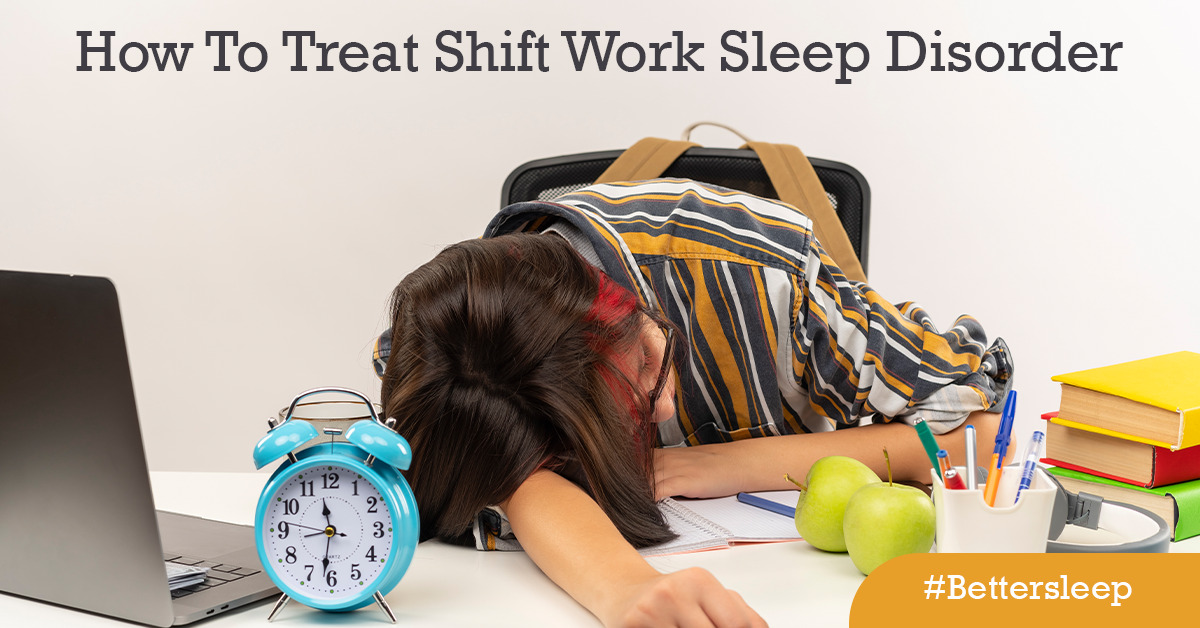How To Treat Shift Work Sleep Disorder

How To Treat Shift Work Sleep Disorder: In industrialized nations, 20% of the workforce1 is thought to work non-standard shifts. Between 10% and 38% of these workers experience shift work disorder, a condition characterized by excessive daytime sleepiness or an inability to sleep at night. In order to successfully adjust to shift work, the body must be trained to sleep at times that may seem strange. EnoughInfo.com

Many shift workers discover that by combining medicine, bright light therapy, and lifestyle changes, they can reduce the symptoms of shift work disorder.
What is shift work sleep disorder?
People who work irregular hours, such as split shifts, graveyard shifts, early morning shifts, or rotating shifts, are more likely to develop shift work sleep disorder (SWSD). Drowsiness, lack of restorative sleep, and extreme sleepiness are its hallmarks. Work and leisure time might both be impacted by these symptoms. How To Cure Insomnia In 12 Minutes
The circadian rhythm, or “biological clock,” of a person might be thrown off by the unconventional work schedule. Throughout the 24-hour day, it controls alertness and sleepiness at largely predictable intervals. When the circadian rhythm is disrupted, it can cause annoying symptoms because it influences:
- sleepiness
- hormone amounts
- hunger
- alertness
- body temperature
According to the Cleveland Clinic, between 10 and 40% of shift workers suffer with SWSD. Most susceptible are those whose schedules frequently change. SWSD doesn’t happen to everyone who works a non-traditional shift, either. Many people who work these shifts naturally fall into the category of “night owls,” and they are able to avoid the condition because of their circadian rhythms.
FAQs & Answers on How To Treat Shift Work Sleep Disorder
1. Can shift work orders be treated?
Yes, shift work sleep disorder (SWSD) can be treated. These symptoms can negatively affect a person’s health and well-being. Treatment options for SWSD include lifestyle changes, environmental adjustments, light therapy, and possibly medication. How To Treat Insomnia During Pregnancy
2. Is shift work sleep disorder permanent?
When the person has to be awake, aware, and productive, they experience extreme tiredness. In SWSD, both symptoms are predominant. There are many different shift work patterns, and they can be permanent, intermittent, or rotating; as a result, the symptoms of SWSD can take many different forms.
3. How long does it take to recover from shift work sleep disorder?
The recovery time for shift work sleep disorder (SWSD) can vary depending on the severity of the symptoms and the individual’s response to treatment. Some people may experience a significant improvement in their sleep quality and overall well-being after making lifestyle changes and implementing environmental adjustments. This can take a few weeks to a few months. However, for some individuals, SWSD may require long-term management with ongoing treatment to maintain healthy sleep habits and manage symptoms. It is important to work with a healthcare provider to develop an individualized treatment plan and monitor progress over time. How To Cure Frequent Nighttime Urination
What effects do shift work sleep disorder (SWSD) have?
increased possibility of
- Blunders at work and accidents.
- Irritability or emotional issues.
- Having trouble coping and having social problems.
- Complaints about one’s health, such as gastrointestinal, cardiovascular, and metabolic issues.
- Reliance on drink and drugs.
How To Treat Shift Work Sleep Disorder
- Adjust your sleep environment: To improve sleep quality, make sure your bedroom is quiet, cool, and dark. Invest in blackout curtains or an eye mask to block out sunlight during the day. Use earplugs or white noise machines to block out noise. How To Deal With A Toxic Person( Step by Step)
- Maintain a consistent sleep schedule: Try to maintain a consistent sleep schedule, even on your days off. This can help regulate your body’s circadian rhythms and improve sleep quality.
- Practice good sleep hygiene: Good sleep hygiene includes avoiding caffeine, nicotine, and alcohol before bed, as well as engaging in relaxing activities before sleep, such as reading or taking a warm bath.
- Consider using light therapy: Light therapy involves using bright lights to simulate sunlight, which can help regulate circadian rhythms and improve sleep quality. Light therapy is typically used for 20-30 minutes in the morning, but the timing and duration of therapy may vary depending on individual needs.
- Take naps: Taking short naps (20-30 minutes) during the day can help alleviate daytime sleepiness and improve alertness. However, be careful not to nap for too long or too late in the day, as this can interfere with nighttime sleep. How To Start An Online Business: 11 Steps To Help You Get Started
- Medications: Your healthcare provider may recommend medication to help improve sleep quality, such as melatonin, prescription sleep aids, or wakefulness-promoting agents. However, these medications should only be used under the guidance of a healthcare provider and should not be used long-term.
- Lifestyle changes: Make sure to engage in regular physical activity, eat a healthy diet, and manage stress to improve overall health and well-being. These lifestyle changes can also help improve sleep quality.
Things you can do to decrease sleep order
- Keep a sleep journal to aid in identifying the issue and track its development over time.
- Reduce the number of consecutive nights worked. The maximum number of nights worked by shift employees should be five or fewer, with days off in between. Shift employees should only work four consecutive shifts when performing 12-hour shifts.
- If at all possible, take more time off than 48 hours after a run of night work.
- Avoid working long hours. Stay away from working long shifts and putting in a lot of overtime. Ensure that you get enough rest and engage in family and social activities. How To Deal With Stress(Guide2023)
- Avoid lengthy commutes because they can interfere with sleep.
- Avoid shifts that rotate frequently. Working a rotating shift schedule is more challenging than working the same shift for an extended length of time.
- Sleep sufficiently on your days off. Create a regimen for your sleep, avoid caffeine, alcohol, and nicotine, and practice proper sleep hygiene. Start a night shift without being sleep deprived.
- Prior to or during the night shift, schedule a nap. Night shift employees’ attentiveness can be increased by naps.
- Don’t drive while fatigued. Take a power nap before your shift if you’re too groggy to drive home, or arrange for another ride. How To Make French Toast(Step by Step)
- When it comes to enhancing alertness during work hours, caffeine and prescription wake-promoting medications like modafinil (Provigil®) and armodafinil (Nuvigil®) both play a part. However, getting enough rest is the best course of action.
- When difficulty falling asleep persists despite using the aforementioned steps, sleep medications may occasionally be recommended.
- Early on in the shift, getting the right amount of light exposure will help you stay more attentive.
Conclusion
In conclusion, shift work sleep disorder (SWSD) can be treated through various approaches such as lifestyle changes, environmental adjustments, and medication or light therapy. By adopting healthy sleep habits, creating a sleep-friendly environment, and seeking medical guidance, individuals with SWSD can improve their sleep quality and reduce the negative impact on their health and well-being. Recovery time can vary based on the severity of the symptoms and individual response to treatment, but with a commitment to positive changes, people with SWSD can successfully manage their condition and enjoy restful, rejuvenating sleep.
Recommended;
How To Treat Rem Sleep Behavior Disorder
22 Ways To Fall Asleep Fast (The Ultimate Guide on Beating Insomnia)
How To Treat Insomnia During Pregnancy




